Speech Australia as a Capital Exporter

Ric Battellino
Assistant Governor (Financial Markets)
Address to Conference on ‘The Impact of An Australia–US Free
Trade Agreement:
Foreign Policy Challenges and Economic Opportunties’
Canberra –
The topic I have been asked to talk about today is Australia as a capital exporter.
At first blush, one might think that this will make for a pretty short talk, as I think we all understand that Australia is an overall capital importer – i.e. in net terms each year, capital flows into the country. This is the counterpart to the current account deficit, and follows from the balance of payments identity.
The relationship between the current account deficit and capital inflow over the past 50 years is shown in Graph 1. For 30 years or so up to about 1980, the current account deficit cycled around an average of 2 per cent of GDP, and net capital inflow cycled around a similar figure. Over the past 20 years, however, both the current account deficit and net capital inflow have been much larger, averaging around 4 per cent of GDP.
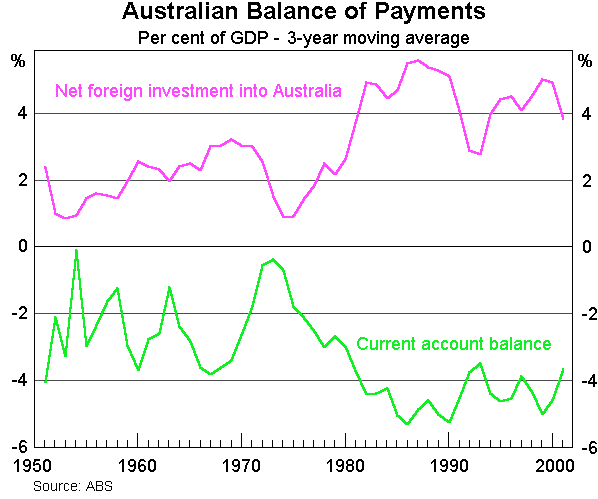
To get to today's topic, we need to look at the gross flows of capital – i.e. inflows and outflows – that underpin the series on net capital inflow shown in Graph 1. What we see here (Graph 2) is that over the past 20 years, both inflows and outflows have increased sharply. In the 1950s, 60s and 70s, capital inflows averaged around 2 per cent of GDP, and capital outflows were negligible. This latter outcome should come as no surprise, as there was a whole raft of exchange controls designed to stop capital flowing out of the country. These were instituted in the lead up to World War II, with the purpose of conserving foreign exchange to support the War effort. That these exchange controls remained in place for forty years after the War gives some indication that concerns about capital outflow are not something new; they have been a feature of Australian economic discussion for much of the past 50 years.
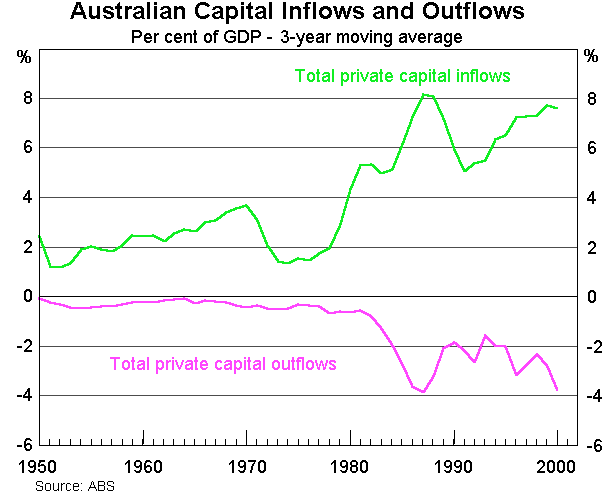
The fixed exchange rate system that existed up to 1983 was at the heart of these concerns. That is, as a country that routinely ran a current account deficit, there was a constant pre-occupation about whether we would attract sufficient net capital inflow to fund that deficit. If we failed to do so, there would be a depletion of official reserve assets, which could eventually result in a balance of payments crisis.
After exchange controls were removed in 1983, capital outflows increased sharply, and over the past 15 years or so have been averaging about 3 per cent of GDP. At the same time, capital inflows increased even more sharply, from around 2 per cent of GDP to around 7 per cent of GDP. In other words, what we saw after the removal of exchange controls and financial deregulation was a sharp increase in capital flows in both directions. This is not surprising, as the removal of financial controls allowed the Australian economy to become more integrated into the world financial system.
The recent public debate about capital outflow seems to be focussed on two main issues. The first is the growing overseas investments of superannuation funds, and the second is the investment offshore by Australian companies. Let me deal with these in turn.
As you can see in Graph 3, superannuation funds have been increasing the proportion of the assets held offshore since the late 1980s. In 1988, the proportion for balanced funds was around 15 per cent; now it is close to double that.
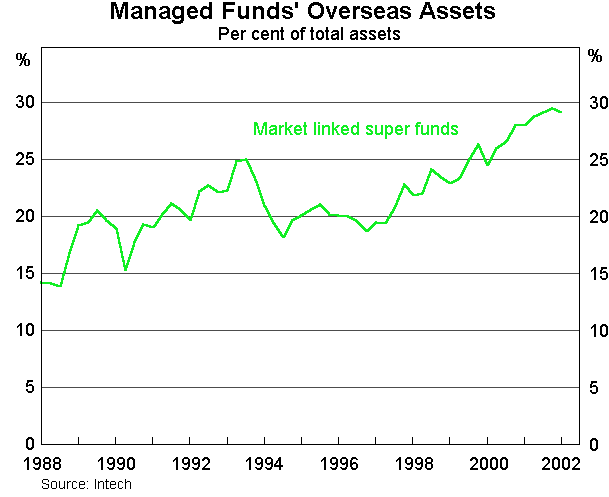
When one combines this rising ratio with a rapidly increasing size of superannuation fund assets, it is pretty easy to generate figures which show the potential for large capital outflows. Commentators sometimes use such calculations to draw pessimistic conclusions about the long-run prospects for the Australian dollar.
Should we be worried about these overseas investments by superannuation funds? I would like to give three reasons why they may not be the problem that some commentators claim:
- First, while commentators often extrapolate from superannuation funds to the whole funds management industry, superannuation funds in fact account for less than half the total funds under management. Other managed funds (e.g. life offices, cash management trusts, friendly societies etc.) typically have smaller proportions of overseas assets than do superannuation funds. As Graph 4 shows, the proportion of all managed funds that is invested overseas is lower than that for superannuation funds, and it has steadied in recent years. Perhaps more importantly, we need to look at the total outflows of portfolio capital, not just the investments by superannuation and other funds managers. Total portfolio outflows are shown in Graph 5. As can be seen, these flows have not changed much as a proportion of GDP over the past decade, suggesting that the increased outflow of superannuation money abroad is displacing other money that was previously flowing abroad.
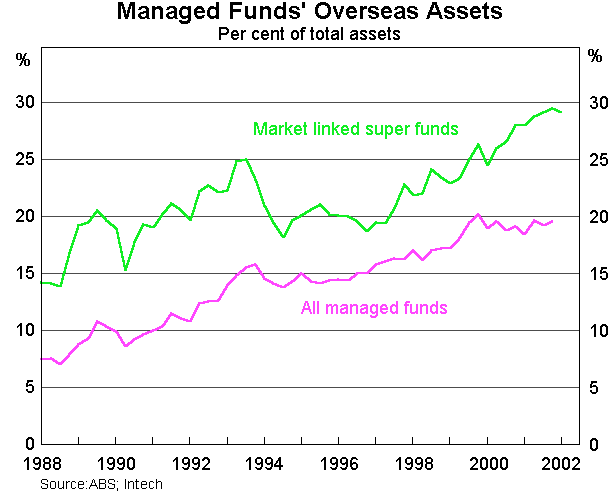
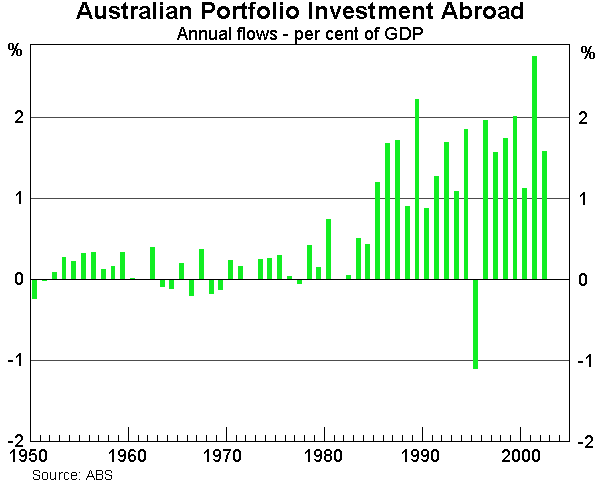
-
Second, there will be a natural limit to the extent to which superannuation funds invest offshore, particularly on an unhedged basis. At present, of the 30 odd per cent invested offshore, about 5 per cent is in offshore bonds and 25 per cent in offshore equities. The bonds are largely hedged in terms of exchange rate risk, but the equities are largely unhedged. It is the equity part of these outflows that has been increasing, so the exposure of superannuation funds to exchange rate movements is rising. Last year, for example, most funds managers made a negative return, and this was largely due to losses on overseas equity investments, averaging around 24 per cent. Of this, 19 percentage points came from falls in share prices and 5 percentage points from the rise in the Australian dollar. In the year before, returns on overseas equities were a negative 6 per cent, but when we look at the factors contributing, we see that share prices fell by 16 per cent and exchange rate gains (stemming from a fall in the Australian dollar) added 10 percentage points to returns.
These figures illustrate that exchange rate gains and losses are having a significant impact on the returns of superannuation funds. There will come a point where superannuation fund trustees will resist further increases in their exposure to exchange rate fluctuations, and direct their funds managers either to stop increasing the allocation to offshore equities or, more likely, to invest on a hedged basis. I would not be surprised if we were already reaching such a point.
- Third, international diversification is happening in other countries too, so we are also the recipient of additional funds from abroad. Some people worry that Australia is only a small country and we will not be "on the radar screen" of foreign funds managers. But because we are only a small country, we only need to attract a small proportion of the international capital flows. On average, we seem to be able to do so, even though there are cyclical swings in the inflows from overseas. As can be seen in Graph 6, portfolio equity inflows into Australia have also increased over the past decade in trend terms. In net terms, Australia remains, on average, a net recipient of portfolio equity flows.
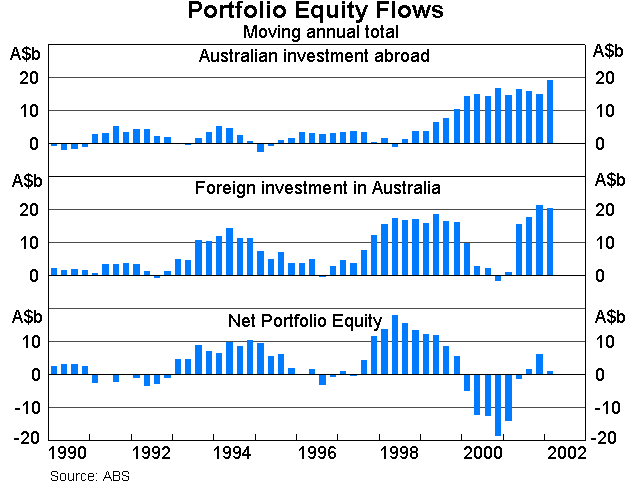
The second issue I highlighted earlier related to foreign direct investment abroad. Basically, this involves Australian companies setting up overseas subsidiaries or taking over foreign companies. This type of activity seems to cause national unease because there is a suspicion that investment overseas by Australian companies must be at the expense of our economy. In particular, there are concerns that jobs will be created overseas rather than at home or that Australia's biggest and best companies will move their operations overseas, leaving Australia as a branch economy.
An indication of the extent to which this is a national concern is given by the fact that recently there have been two major studies of foreign investment abroad by Australian companies: one by the Productivity Commission and one by the Department of Foreign Affairs and Trade[1] . Both found a very high level of foreign participation by Australian firms. Both also concluded that, on balance, foreign investment by Australian companies was a good thing for the economy. As well as the profits that flow from such operations, the studies found that there could also be positive spin-offs for firms' domestic operations.
In most cases, companies undertook offshore investment because they had developed strong skills and expertise within their particular fields, which they could profitably take overseas. Negative reasons for moving operations overseas – e.g. because there was something wrong with the Australian business environment – seemed to be in a minority.
Let me run briefly through the facts. Graph 7 shows the annual flows of direct foreign investment by Australians, measured as a per cent of GDP. The sharp increase over the past decade or two is clear. These flows are, on average, about the same size as the portfolio outflows by funds managers.
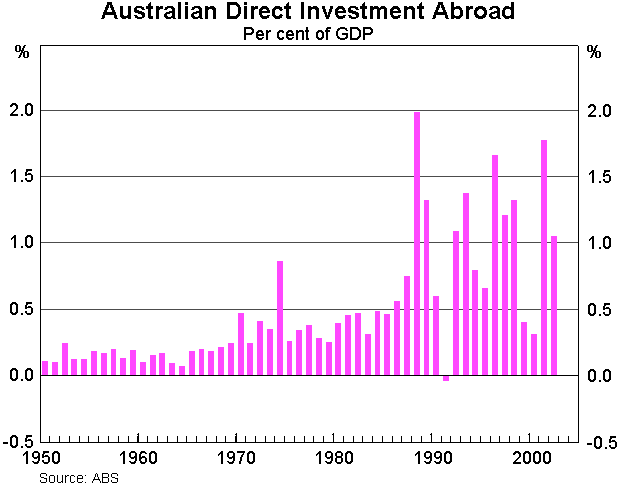
Which companies are undertaking this investment? The study by the Department of Foreign Affairs and Trade found that the bulk of foreign investment was undertaken by a relatively small number of large companies. When it listed the 100 largest companies ranked by size of revenue, assets and employment, it found that there were 26 companies which made all three lists. It took this group as being representative of large companies in Australia. Of these 26 companies, 20 had offshore operations and they accounted for 84 per cent of total foreign direct investment by Australians.
Table 1 shows the proportion of overseas assets of each of these companies in 1999/2000 and five years earlier. Of the 20 companies with offshore operations, 15 increased the size of those operations over the five-year period, with offshore investment in 1999/2000 averaging 35 per cent of total assets, compared with 30 per cent in 1994/95.
| Company | Per cent of total assets | |
|---|---|---|
| 1994/95 | 1999/00 | |
| News Corp | 81 | 89 |
| QBE | 51 | 76 |
| Brambles | 60 | 69 |
| Pioneer | 40 | 62 |
| AMP | 44 | 61 |
| Rio Tinto | 61 | 60 |
| Coca Cola | 48 | 59 |
| Lend Lease | 11 | 57 |
| Pac Dunlop | 39 | 53 |
| NAB | 42 | 46 |
| Amcor | 33 | 46 |
| MIM | 28 | 44 |
| BHP | 36 | 41 |
| CSR | 34 | 41 |
| ANZ | 40 | 26 |
| Boral | 23 | 24 |
| Fosters | 55 | 21 |
| Westpac | 27 | 20 |
| CBA | 15 | 14 |
| Telstra | 0 | 8 |
| Coles Myer | 0 | 0 |
| Woolworths | 0 | 0 |
| Qantas | 0 | 0 |
| C&W Optus | 0 | 0 |
| St George | 0 | 0 |
| PBL | 0 | 0 |
|
Source: DFAT |
||
The bulk of foreign direct investment by Australian firms is in the United States. Investment by Australian companies in the US at June 2001 was $95 billion or 55 per cent of total foreign direct investment (Graph 8). The second most important destination was the UK at 17 per cent, with Continental Europe, Asia and New Zealand all roughly similar at $13 billion or 8 per cent of the total.
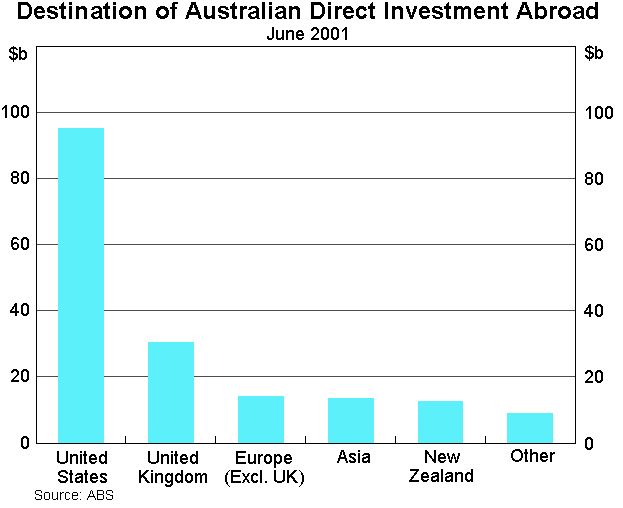
I should note too that the US is also the main destination of portfolio outflows (i.e. offshore investments by funds managers) accounting for 46 per cent of the total of such flows. Europe is the next most important. Overall, the weighting patterns for portfolio flows are not too different from the weights in the MSCI World Index, which is not surprising given that this is the index that many funds managers benchmark themselves against.
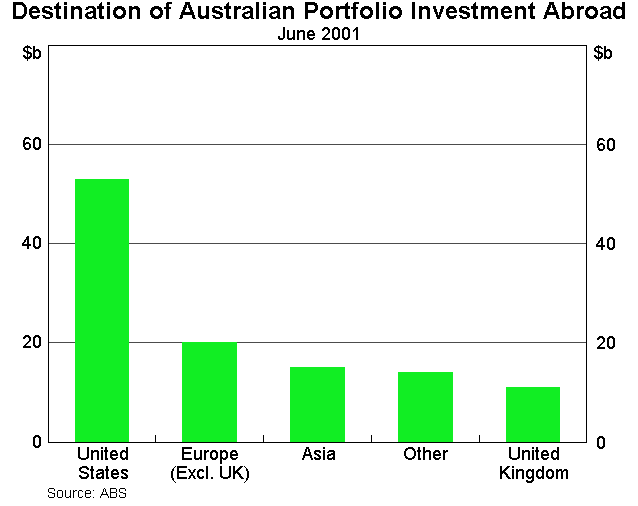
The trends towards increased offshore investment by Australian companies is by no means unusual. Graph 10 shows that over the past decade, foreign direct investment by companies in all the large industrial countries, apart from Japan, increased sharply. The ratio of foreign direct investment to GDP roughly doubled in all these countries, as it did in Australia.
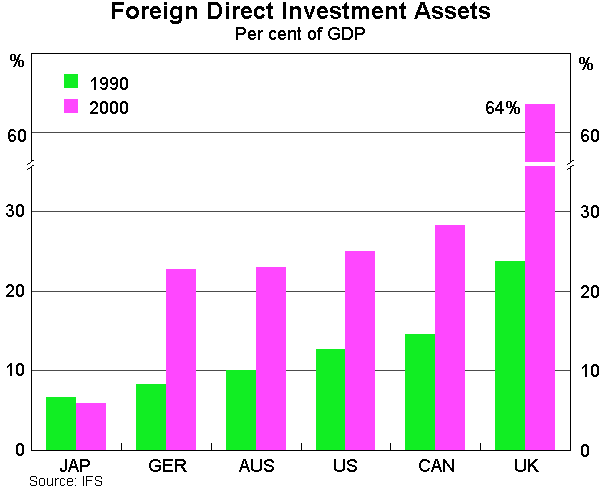
Conclusion
Let me conclude by summarising a few key points:
- First, Australia has become a much more important exporter of capital since the removal of exchange controls and other financial deregulation in the 1980s.
- Second, even though public debate suggests that there are some reservations in the community about such investment, detailed studies in this area mostly reach the conclusion that such investment is favourable for the Australian economy overall.
- Third, while we are often tempted to try to explain these trends in terms of factors specific to Australia, the fact is that the same trends are apparent in virtually all industrial countries. The widespread trend towards increased offshore investment seems to reflect the globalisation of economies and capital markets, rather than developments specific to any particular country.
- Fourth, while we focus a lot on the capital flowing out of the country we should not lose sight of the fact that, in net terms, Australia remains a recipient of capital inflows.
Endnote
Productivity Commission, Offshore Investment by Australian
Firms: Survey Evidence, Commission Research Paper, February 2002
Department of Foreign Affairs and Trade, The Big End of Town
and Australia's Trading Interests, April 2002
[1]